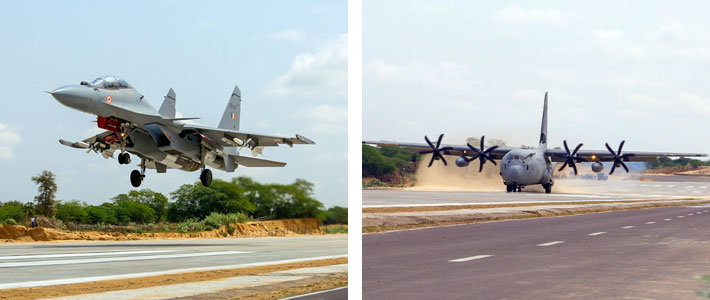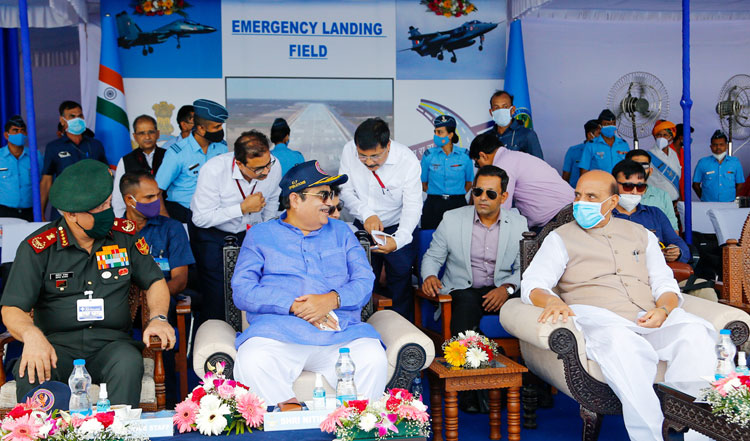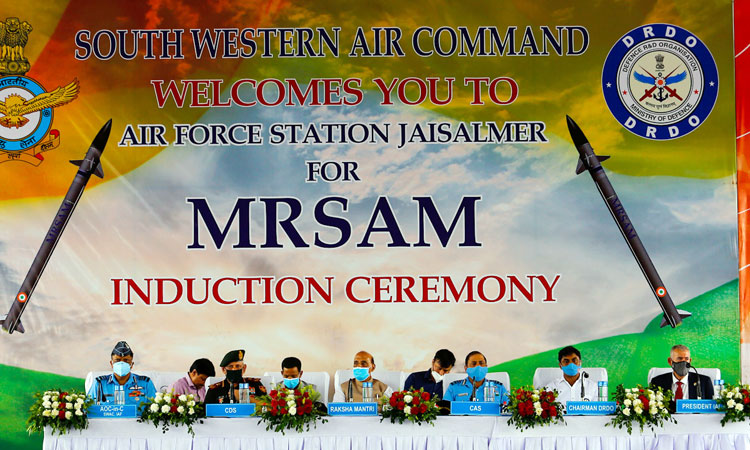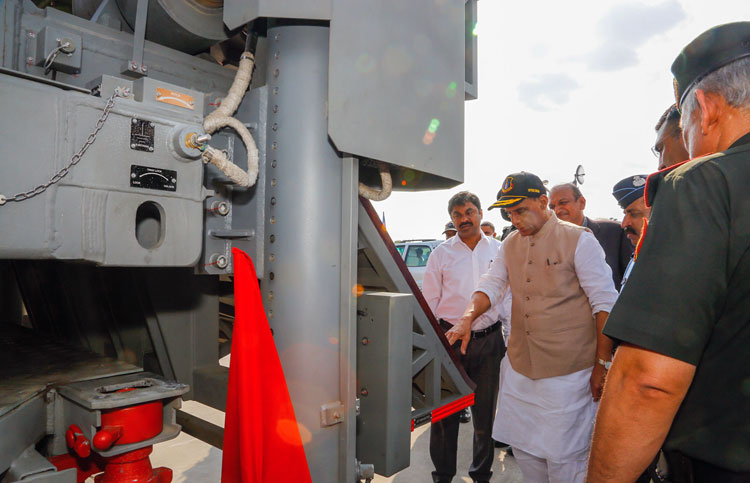INDIAN ARMED FORCES CHIEFS ON OUR RELENTLESS AND FOCUSED PUBLISHING EFFORTS

The insightful articles, inspiring narrations and analytical perspectives presented by the Editorial Team, establish an alluring connect with the reader. My compliments and best wishes to SP Guide Publications.

"Over the past 60 years, the growth of SP Guide Publications has mirrored the rising stature of Indian Navy. Its well-researched and informative magazines on Defence and Aerospace sector have served to shape an educated opinion of our military personnel, policy makers and the public alike. I wish SP's Publication team continued success, fair winds and following seas in all future endeavour!"

Since, its inception in 1964, SP Guide Publications has consistently demonstrated commitment to high-quality journalism in the aerospace and defence sectors, earning a well-deserved reputation as Asia's largest media house in this domain. I wish SP Guide Publications continued success in its pursuit of excellence.
- Prime Minister Modi Visits Punjab’s Adampur Air Base, Interacts with Airmen after Successful ‘Operation Sindoor’; Stern Message to Pakistan
- The layered Air Defence systems that worked superbly, the key element of Operation Sindoor
- Operation Sindoor | Day 2 DGMOs Briefing
- Operation Sindoor: Resolute yet Restrained
- India's Operation Sindoor Sends a Clear Message to Terror and the World – ‘ZERO TOLERANCE’
- Japan and India set forth a defence cooperation consultancy framework, talks on tank and jet engines
Significant boost for the Indian Air Force
Defence Minister Rajnath Singh inaugurates National highway being used for emergency landing of IAF aircraft for the first time and later inducts MRSAM into the IAF

On Thursday, September 9, 2021, Defence Minister Rajnath Singh and Minister for Road Transport and Highways Nitin Gadkari jointly inaugurated Emergency Landing Facility (ELF) for the Indian Air Force at Satta-Gandhav stretch on NH-925A near Barmer, Rajasthan. The two Ministers travelled to Barmer on C-130J aircraft to inaugurate the facility. This is the first time that a National Highway has been used for emergency landing of aircraft of the Indian Air Force (IAF). This landing strip will be able to facilitate landing of all types of IAF aircraft.

The ministers also witnessed aircraft operations on the Emergency Landing Facility, which has been constructed in a duration of 19 months by GHV India Pvt. Ltd. under the supervision of the IAF and National Highways Authority of India (NHAI), informed the official statement.
Emergency Landing Facility on Satta-Gandhav stretch of NH-925A near Barmer is being inaugurated. Watch https://t.co/MykNONmJQX
— Rajnath Singh (@rajnathsingh) September 9, 2021
Praising the IAF, NHAI & the private sector for coming together to complete the construction of ELF in 19 months despite COVID-19 restrictions, the Defence Minister said, “It is a great example of coordination among multiple departments & ministries, government & private sector and civil & defence. The landing of IAF aircraft on the 3 km stretch is a historic new strength of new India, as it coincides with the 75th year of Independence and 50th year of India’s victory in the 1971 war.”
This landing strip will be able to facilitate landing of all types of IAF aircraft.
“This highway run-way will further strengthen the country's security in protecting the borders which are strategically important,” said Union minister for Road Transport and Highways Nitin Gadkari.
The three-kilometre section as an ELF has been developed by NHAI for the IAF. The statement added that it is part of the newly-developed two-lane paved shoulder of Gagariya-Bakhasar & Satta-Gandhav section having total length of 196.97 kilometres and costing 765.52 crore under Bharatmala Pariyojana. The work commenced in July 2019 and was completed in January 2021.
I thank @MORTHIndia Shri @nitin_gadkari for constructing such impressive road infrastructure in record time.
— Rajnath Singh (@rajnathsingh) September 9, 2021
The roads and highways projects being undertaken by our government have proved that defence and development are not two separate entities. Both complement each other.
“This highway and landing field will further cement the basic infrastructure along the western border and strengthen national security. Such emergency fields will provide more edge to the operational and civil assistance of our forces. It will also play a crucial role in facing natural calamities,” said Singh.
The stretch located in the western border area is expected to facilitate the vigilance of the Indian Army and strengthen the basic infrastructure of the country. During normal time, the ELF will be used for smooth flow of road traffic. Apart from the Emergency Landing Strip, three helipads have been constructed in Kundanpura, Singhania & Bakhasar villages under this project as per the requirements of the Armed Forces.
19 other locations across the nation to have ELF.
The government ensured its resolve to bolster the network of roads and highways across the country, with focus on constructing emergency landing fields at strategic and important places. He stated that the continuous construction of roads, highways and bridges across the country reflects the Government’s commitment towards nation building. “The roads and highways projects being undertaken by our government have proved that defence and development are not two separate entities. Both complement each other,” Singh added. Also referring to the Cabinet’s approval to procurement of 56 C-295MW transport aircraft for Indian Air Force, the Defence Minister said the decision was a big step towards ‘Atmanirbhar Bharat’ since the aircraft would be manufactured under the 'Make in India' initiative.
Apart from the Emergency Landing Strip, three helipads have been constructed in Kundanpura, Singhania & Bakhasar villages under this project as per the requirements of the Armed Forces.
19 other locations across the nation will have ELF. “In 2016, our government had identified 29 places across the country by forming an inter-ministerial committee for such emergency landing fields. Out of these 11 spots are on national highways,” informed Singh.
‘???????? ????????’ ??? ??? ?? ?? ????????????? ???????? ??? ?? ??? ?? ????? ???? ?? districts ?? ?? ??? ?????? ???, ???? ??? ????? ?? ??????? ?? ??????? ?? ???? ??????: ????? ??????
— ????? ?????? ????????/ RMO India (@DefenceMinIndia) September 9, 2021
ELF to be developed at 19 other places in the country:
on Phalodi – Jaisalmer road and Barmer – Jaisalmer road in Rajasthan, Kharagpur – Balasore road in West Bengal, Kharagpur – Keonjhar road and near Panagarh/KKD, Chennai in Tamil Nadu, on Puducherry road, in Andhra Pradesh on Nellore – Ongole road and Ongole – Chilakaluripet road, in Haryana on Mandi Dabwali to Odhan road, near Sangrur in Punjab, on Bhuj-Naliya road in Gujarat and on Surat-Baroda road, in Jammu and Kashmir in the Banihal-Srinagar road , Leh/Nyoma area in Assam and on the Jorhat-Baraghat road, near Sivasagar, Bagdogra-Hashimara road, Hashimara-Tezpur route and Hashimara-Guwahati road in Assam
Induction of the MRSAM missile system
After inaugurating the ELF inauguration, Defence Minister Rajnath Singh attended the induction ceremony of MRSAM into the IAF. Being termed as a significant boost to India’s defence capabilities, the first deliverable Firing Unit (FU) of Medium Range Surface to Air Missile (MRSAM) System was handed over to IAF at Air Force Station, Jaisalmer in Rajasthan on Thursday.
The MRSAM System is being inducted in the IAF today. This is another step towards self-reliance in indigenous defence technologies. https://t.co/g51TKX2agR
— Rajnath Singh (@rajnathsingh) September 9, 2021
The MRSAM (IAF) is an advanced network centric combat Air Defence System developed jointly by Defence Research and Development Organisation (DRDO) and Israel Aerospace Industries (IAI) in collaboration with the Indian industry comprising of private and public sectors including MSMEs.

DRDO Chairman, Dr G. Satheesh Reddy handed over the first deliverable FU to Chief of Air Staff, Air Chief Marshal R.K.S. Bhadauria. During the event, DRDO and IAI officials demonstrated the capabilities of MRSAM system, as part of On-Site Acceptance Test (OSAT). Air Chief Marshal Bhadauria affirmed that the system will bolster the air defence capabilities of the country.
DRDO handed over air defence Medium Range Surface to Air Missile (MRSAM) System to the IAF.
The MRSAM system provides point and area air defence for ground assets against a wide range of threats including fighter aircraft, UAVs, helicopters, guided and unguided munitions, sub-sonic & supersonic cruise missiles etc. It is capable of engaging multiple targets at ranges up to 70 kms in severe saturation scenarios, informed the official statement. The missile is powered by indigenously developed rocket motor and control system for achieving high maneuverability during the terminal phase.
????? Geo-politics ?? ?????? ?????, ???????, ???? ????????? ?? ??? ???? ??? security scenario ?? ?? ???? ?? ???? ??? ??? ?????? ???, ????? ??????? ?? ?????? ?? ???????????? ?? ??????? ? ???? ?? ????? ?? ???? ??: ????? ??????
— ????? ?????? ????????/ RMO India (@DefenceMinIndia) September 9, 2021
Appreciating the joint efforts of DRDO, IAI, various inspection agencies, public & private industry partners in developing, the Defence Minister termed the MRSAM as one of the best state-of-the-art missile systems in the world that will prove to be a game changer in the airdefence system.

The Minister reiterated that the government is determined to strengthen the security infrastructure of the country to deal with any challenges arising out of the rapidly changing global strategic scenario. “Modernisation of the Armed Forces and building a self-reliant defence industry are being accorded top priority. Government is leaving no stone unturned to ensure the security and overall development of the country like setting up of Defence Industrials Corridors in Uttar Pradesh and Tamil Nadu; corporatisation of Ordnance Factory Board; notification of two positive indigenisation lists of over 200 items to increase exports and Transfer of Technology (ToT) by DRDO to the private sector.”
??? ????? ???, ?? ????? ?????? ?? ???? ??? ?? ????? ??????? ?? ?????? ???? ???? ??, ????? ??? ?? over-all growth ?? ????????? ???? ??? ?? ??????, ?? ?? ?? programme ?? handing over ?? ???? ??, ??? ?? ??????? ?? ????? ????? ?? ???? ?????? ?? ??????? ???: ????? ??????
— ????? ?????? ????????/ RMO India (@DefenceMinIndia) September 9, 2021
Singh who is confident that India will soon become self-reliant in defence manufacturing as well as a global manufacturing hub of defence systems, reaffirmed the commitment to nourish the technological base through indigenous research, design and development, with focus on 'Make in India', 'Make for the world'. He highlighted that close cooperation between technology partners & friendly countries has led to rapid progress towards realising this vision and development of MRSAM is a great example of such collaborative effort.
?? missile system ?? ?????? ?? ??? ?????? ?? ?? ?? state-of-the-art Missile systems ??? ?? ?? ??? ????? ??????? ??? ?? ??? ?? development, ?????? ??? ???? ?? ?????? ?? ?????? ???????? ??? ?? ????? ?? ?????? ??: ????? ?????? ???? @rajnathsingh
— ????? ?????? ????????/ RMO India (@DefenceMinIndia) September 9, 2021
The new test facilities and infrastructure created in the development of this programmeare deemed to prove helpful in producing quality products for both the countries in the future. “The sub-systems being manufactured for this programme as a great example of synergy between Indian public and private sector companies,” he said.
MRSAM will prove to be a game changer in the air-defence-system: Defence Minister
The firing unit of the system comprises of Missiles, Combat Management System (CMS), Mobile Launcher Systems (MLS), Advanced Long Range Radar, Mobile Power System (MPS), Radar Power System (RPS), Reloader Vehicle (RV) and Field Service Vehicle (FSV).
During his address, the Minister remembered former President Dr. A.P.J. Abdul Kalam, terming him a visionary who paved the way for self-reliance in defence sector, especially in the missile development programme. “Around 30 years ago Dr. Kalam initiated the Integrated Missile Development Programme at a time when scientists were facing various restrictions in the field of technology. Despite all this, the success of the programme not only ensured self-reliance in missile development, but also thwarted possibility of any cross-border threat.”





